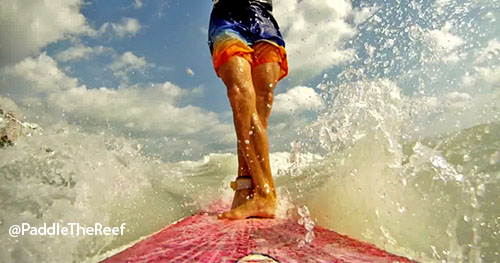
by Todd Fox
I’m a Bunhead Surfaholic!!! That’s right, my career focus and lifelong passion has always been ballet and there’s not many things in this world I love as much as ballet, but surfing is definitely one of them. I surf every chance I get and am probably one of the only surfers in Florida who strikes ballet poses while riding a wave. Over the years I’ve surfed on all sorts of boards including long boards, short boards, foam boards, plank boards with no fins, kayaks, canoes, boogie boards, etc.– if it floats I’ve surfed it and probably tried to do some ballet on it as well.
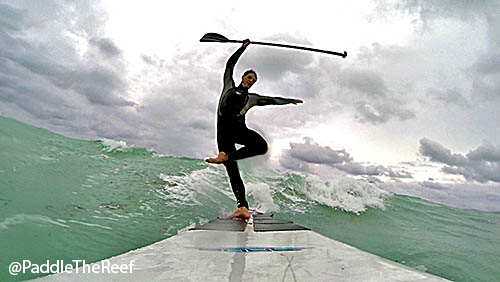
A few years ago I began noticing more and more stand up paddleboard (SUP) surfers catching waves at the local surf breaks here where I live in Miami. I had previously paddled a SUP on our calm south Florida inter-coastal waters and it was super fun but surfing on a stand up paddleboard looked intense. I couldn’t believe surfers were dropping in on waist to chest high waves while using a paddle to maneuver these giant heavy SUP boards. It looked like an incredible workout as well as a ton of fun so I decided to give it a try and bought a used 10’6″ Surfseries SUP off Craigslist to start learning with.
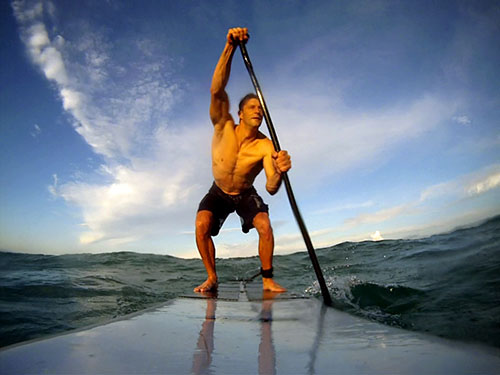
I had been a traditional board surfer for many years and figured the transition to surfing on a SUP would be relatively easy, plus I’m a professional ballet dancer and have good strength/balance/coordination, right? WRONG!!! I couldn’t believe how incredibly difficult it was to balance on a SUP in choppy water and the workout was much more intense than I imagined, it gave a whole new meaning to the word exhaustion. Paddling a SUP on nice glassy calm water is an amazing full-body workout but when you add waves, rip currents, and rough surf to the equation, the physical demands become much more extreme. Complicating matters was the fact that where I surf most often, Miami Beach, rarely has “clean” easy-to-paddle surf, most of our good surf is accompanied by rough, choppy ocean conditions. Without going into too much detail, this is due to Miami’s geographic proximity to the island chain of the Bahamas located directly to our east. On my first attempts I could only manage to stand on the SUP briefly, once the board started to wobble or bob up and down as a result of the choppy surface water, I would immediately lose balance and fall off every time.
After a couple frustrating sessions of continuously falling off the board I decided to take a few steps back and started watching instructional videos online that offered tips/tricks. Most instructors said the key to absorbing waves and counterbalancing while surfing on a SUP is to strengthen and control the “bend in your knees”, or as they say in my line of work, plié. HOORAY Plié!!! So, I began to focus on over-strengthening, if there is such a thing, the muscles that control my demi-pliés. I found that doing super slow 32-count grand pliés in first, second, and fifth positions every day until the muscles in my legs burned from exhaustion was very effective in a short period of time. Although while standing on a SUP your feet are almost always in a parallel, turned-in position, doing these slow pliés in turned-out, balletic positions made the turned in stance even easier to maintain while counterbalancing. A super strong controlled demi-plié was the golden ticket.
Once I developed enough strength and coordination to stand and paddle in rough surf, the next step was to learn how to paddle into a surfable wave. This took a considerable amount of practice but it was fun, so much fun. Basically you have to learn how to paddle your SUP parallel to the shoreline and, when a wave approaches, quickly turn the SUP using the paddle so it is on the correct angle with the nose pointing at the shoreline and then paddle as fast as you can in order to build enough speed to catch the oncoming wave behind you.
This is where SUP surfing is fundamentally different from traditional surfboard surfing. On a surfboard you want to be in the water at a location just about where the wave peaks in height, and, as the undercurrent picks you up to the top of the wave, you paddle and pop up onto the board, dropping in on a forward-pitched angle to surf the wave. When you’re surfing, the pop up and drop onto a wave always seems to go in super slow motion but, in reality, they both happen in about 2 seconds. Unfortunately, SUPs are generally too big and heavy to gather enough speed and momentum in that short a period of time, so, as a result, you have to be a bit further offshore where the waves are just beginning to build and paddle in front of them. As the wave builds larger and larger behind you, the forward momentum builds, significantly propelling the SUP forward faster and faster so that by the time the wave is at its peak in height (hopefully with you on the top edge of it) you have the amount of speed necessary to initiate the drop and surf down the line of the wave.
For those of you reading this who are not familiar with surfing terminology, “the drop”, “drop-in”, or “dropping in” refers to the beginning of the ride when the momentum of the wave begins to pitch the board forward and you drop on a downward angle onto the face or “wall” of the wave. While dropping in on a wave, the speed of your forward momentum increases significantly, you basically go from 3 miles per hour to 25 miles per hour in about 2 seconds on a downwards angle while hopefully balancing on the board. Depending on the size and speed of the wave, “the drop” is an incredible adrenaline rush and can be the best part of the ride.
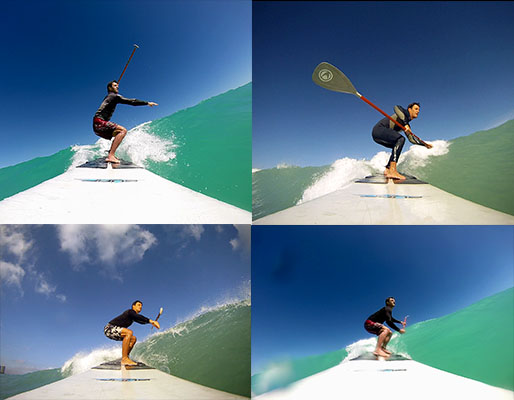
Executing a successful drop on a SUP is quite unique. It requires a 45 degree angle shift in foot and body stance from your paddle position, which faces directly forward on the board, to your surf stance position which faces left or right depending on the side you surf best. Most instructors I spoke to and watched online said the easiest way to change your foot position is simply step one leg back and, once placed, shift your body into surfing position. When I was learning, I found it very difficult to maintain balance in this manner and then I saw some SUP surfers online who were switching their foot positions with a little hop in between. It was like a little, turned-in échappé but with a strong, heavy emphasis on the landing, which helps to shift the board weight forward, initiating the drop. The more I practiced it the better I got, and, naturally, I just had to come up with a ballet-related exercise to help build some proper bunhead SUP surfing strength. It’s a very simple but effective échappé workout which is just 4 petite échappé jumps in a row starting from 5th position, but, when landing each time in second position, controlling the plié from the second your feet touch the ground so that you sink into the position as slowly as possible, while, at the same time, gripping all the muscles in your legs until they burn from exhaustion. It doesn’t sound like much but trust me when I say if done properly this simple échappé exercise is incredibly effective in developing the leg strength needed to hop into surf position on a SUP and absorb the dynamic instability of a large drop without wiping out and potentially injuring yourself.
There’s also another method to SUP surfing which I like to call “Lazy SUP Surfing” because you paddle the board while on your knees and pop up right into surfing position, there is no little échappé switch stance. As a result of sitting on your knees and paddling, this method requires much less strength overall and saves lots of energy. It’s good for when the waves are nice and big and you need to conserve strength to stay out on the water surfing for hours on end.
As a dancer, I can tell you firsthand that there are some amazing therapeutic benefits to SUP surfing. Throughout my 20+ year career as a ballet dancer I have sustained numerous injuries to both my ankles and feet including sprains, twists, fractures, stretched ligaments, broken metatarsals, etc. As a result, I have to do an almost daily stretching and strengthening regiment to keep my ankles and feet as strong as possible while maintaining a good range of motion and sense of proprioception. Any dancer who has ever sustained a bad ankle or foot injury knows what a BAPS board is and I’m not kidding when I say just a few minutes of standing and trying to stabilize your weight on a SUP in choppy surf is like a BAPS board workout on CRACK! My legs and ankles never feel as strong and solid as when I’m SUP surfing regularly.
Aside from the therapeutic benefits and full-body workout, I actually experience improvements in my dancing when I’m able to SUP surf on a regular basis. Pas de deux stamina increases 100 fold and signature male balletic movements like double tour en l’air, pirouettes, coupe jetes, and double soudebasques always feel more solid and effortless. I’m not an expert in anatomy or kinesiology but I can tell you from experience that the paddling portion of SUP surfing challenges the muscle groups in your upper body in ways you’ve never experienced before. After just a couple of sessions I always feel as if I have the upper body strength to toss any size ballerina 10 feet up in the air.
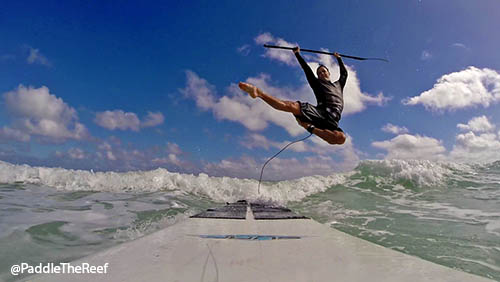
If you’re reading this and decide to give SUPing or SUP surfing a try, and I highly recommend that you do, just remember to start slow, be safe, strengthen that demi plie, and most importantly have fun!!!
And if you’re interested in hooking up with Todd, follow him @elitedance on Twitter. He tweets up a storm!
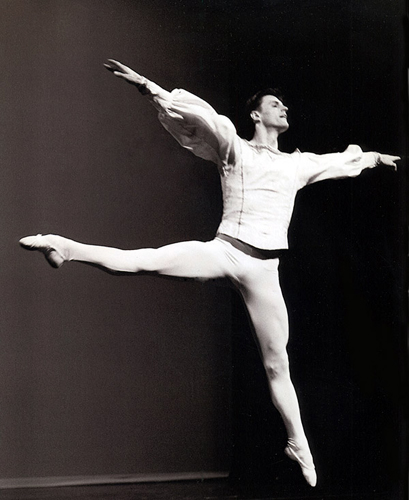
Throughout his professional career Contributor Todd Fox has performed with ballet companies around the world including Ireland’s Cork City Ballet, South Africa’s Ballet Theatre Afrikan, Yugoslavia’s Serbian National Theatre Ballet, Scotland’s Ballet West, Venezuela’s Ballet Metropolitano de Caracas, Ballet Concierto de Puerto Rico, Isle of Man’s Manx Ballet, and the USA’s Cleveland San Jose Ballet, BalletNY, and Joffrey II Dancers.
Described by the New York Times’ Jack Anderson as, “most notable for his effortless jumps”, Mr. Fox’s performance repertoire includes such favorites as Albrecht in Lavrovsky’s Giselle, the Angel in Rudolph Van Dantzig’s Four Last Songs, Pas de Cinq in Rudolph Nureyev’s Sleeping Beauty, The Fool in Agnes de Mille’s Three Virgins and a Devil, Stanton Welch’s Orange, George Balanchine’s Apollo, Valse Fantaisie, and Tchaikovsky Pas de Deux, Escamillo in Roland Petit’s Carmen, Gerald Arpino’s Kettentanz, and Antony Tudor’s Continuo.
Theatrical credits include the Off-Broadway production of Life’s Too Short to Cry, National Tours of Dreamgirls, Cinderella starring Phyllis Diller, the Teenage Mutant Ninja Turtles Out of Their Shells Tour!, and most recently Todd originated the role of Police Chief Louis Renault in Warner Brothers Theatre Ventures’ original production of John Clifford’s Casablanca The Dance. Television appearances include performances on Live with Regis and Kathie Lee, the RTÉ broadcast network reality series Ballet Chancers, The Drew Carey Show, and in the Emmy nominated broadcast of Blue Suede Shoes.
Since 1998 Todd has worked as an agent/manager specializing in the representation of high profile guest artist ballet dancers from around the world. He has successfully negotiated contracts for many clients governing a wide array of live performance engagements and film.





The Todd Fox post is excellent. I’ve been a dancer, choreographer, ballet-master, director, teacher and dance scientist all over the world for 50 years, and I’ve seldom encountered anyone with such a refreshing lack of pretentiousness. Ours is a wonderful profession, but it does encourage a certain precious quality among some of its adherents — this guy is so encouraging, because he’s just enjoying it, without any airs and graces. Also, he can write, grammatically and effectively. Very enjoyable — we could do with more of this kind of thing.
Thank you for the wonderful comment! I know exactly what you mean about Todd – his enthusiasm shines through! He just wants people to enjoy life–and enjoy dance. It’s contagious!
Wow, thanks so much for the kind words Jeremy, really appreciate that.
You’re right Catherine I just want people to enjoy life, and dance, and SURF! 😉